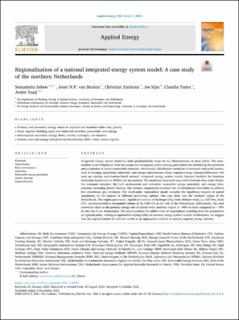| dc.contributor.author | Sahoo, Somadutta | |
| dc.contributor.author | van Stralen, Joost | |
| dc.contributor.author | Zuidema, Christian | |
| dc.contributor.author | Sijm, Jos | |
| dc.contributor.author | Yamu, Claudia | |
| dc.contributor.author | Faaij, Andre PC | |
| dc.coverage.spatial | Netherlands | en_US |
| dc.date.accessioned | 2022-04-20T07:56:50Z | |
| dc.date.available | 2022-04-20T07:56:50Z | |
| dc.date.created | 2021-11-08T14:12:17Z | |
| dc.date.issued | 2021-11-05 | |
| dc.identifier.issn | 0306-2619 | |
| dc.identifier.issn | 1872-9118 | |
| dc.identifier.uri | https://hdl.handle.net/11250/2991505 | |
| dc.description.abstract | Integrated energy system modeling tools predominantly focus on the (inter)national or local scales. The intermediate level is important from the perspective of regional policy making, particularly for identifying the potentials and constraints of various renewable resources. Additionally, distribution variations of economic and social sectors, such as housing, agriculture, industries, and energy infrastructure, foster regional energy demand differences. We used an existing optimization-based national integrated energy system model, Options Portfolio for Emission Reduction Assessment or OPERA, for our analysis. The modeling framework was subdivided into four major blocks: the economic structure, the built environment and industries, renewable energy potentials, and energy infrastructure, including district heating. Our scenario emphasized extensive use of intermittent renewables to achieve low greenhouse gas emissions. Our multi-node, regionalized model revealed the significant impacts of spatial parameters on the outputs of different technology options. Our case study was the northern region of the Netherlands. The region generated a significant amount of hydrogen (H2) from offshore wind, i.e. 620 Peta Joule (PJ), and transmitted a substantial volume of H2 (390 PJ) to the rest of the Netherlands. Additionally, the total renewable share in the primary energy mix of almost every northern region is ~90% or more compared to ~70% for the rest of the Netherlands. The results confirm the added value of regionalized modeling from the perspective of regional policy making as opposed to relying solely on national energy system models. Furthermore, we suggest that the regionalization of national models is an appropriate method to analyze regional energy systems. | en_US |
| dc.description.sponsorship | This research was supported provided by the ESTRAC Integrated Energy System Analysis Project financed by the New Energy Coalition (finance code: 656039). | en_US |
| dc.language.iso | eng | en_US |
| dc.publisher | Elsevier | en_US |
| dc.relation.ispartofseries | Applied Energy;Volume 306, Part B, 15 January 2022, 118035 | |
| dc.rights | Navngivelse 4.0 Internasjonal | * |
| dc.rights.uri | http://creativecommons.org/licenses/by/4.0/deed.no | * |
| dc.subject | Optimization | en_US |
| dc.subject | Built environments | en_US |
| dc.subject | Industries | en_US |
| dc.subject | Renewable energy potentials | en_US |
| dc.subject | District heating | en_US |
| dc.subject | Regionalization | en_US |
| dc.title | Regionalization of a national integrated energy system: A case study of the northern Netherlands | en_US |
| dc.type | Peer reviewed | en_US |
| dc.type | Journal article | en_US |
| dc.description.version | publishedVersion | en_US |
| dc.rights.holder | © 2021 The Authors | en_US |
| dc.source.articlenumber | 118035 | en_US |
| cristin.ispublished | true | |
| cristin.fulltext | original | |
| cristin.qualitycode | 1 | |
| dc.identifier.doi | https://doi.org/10.1016/j.apenergy.2021.118035 | |
| dc.identifier.cristin | 1952366 | |
| dc.source.journal | Applied Energy | en_US |
| dc.source.volume | 306 | en_US |
| dc.source.issue | Part B | en_US |
| dc.source.pagenumber | 40 | en_US |
| dc.relation.project | New Energy Coalition: 656039 | en_US |

